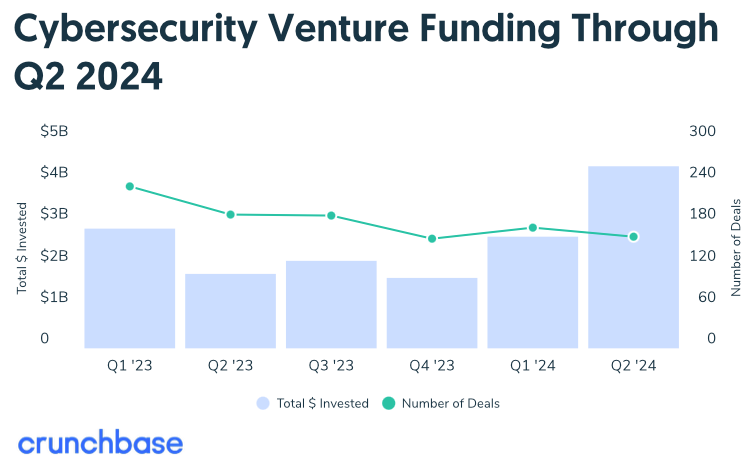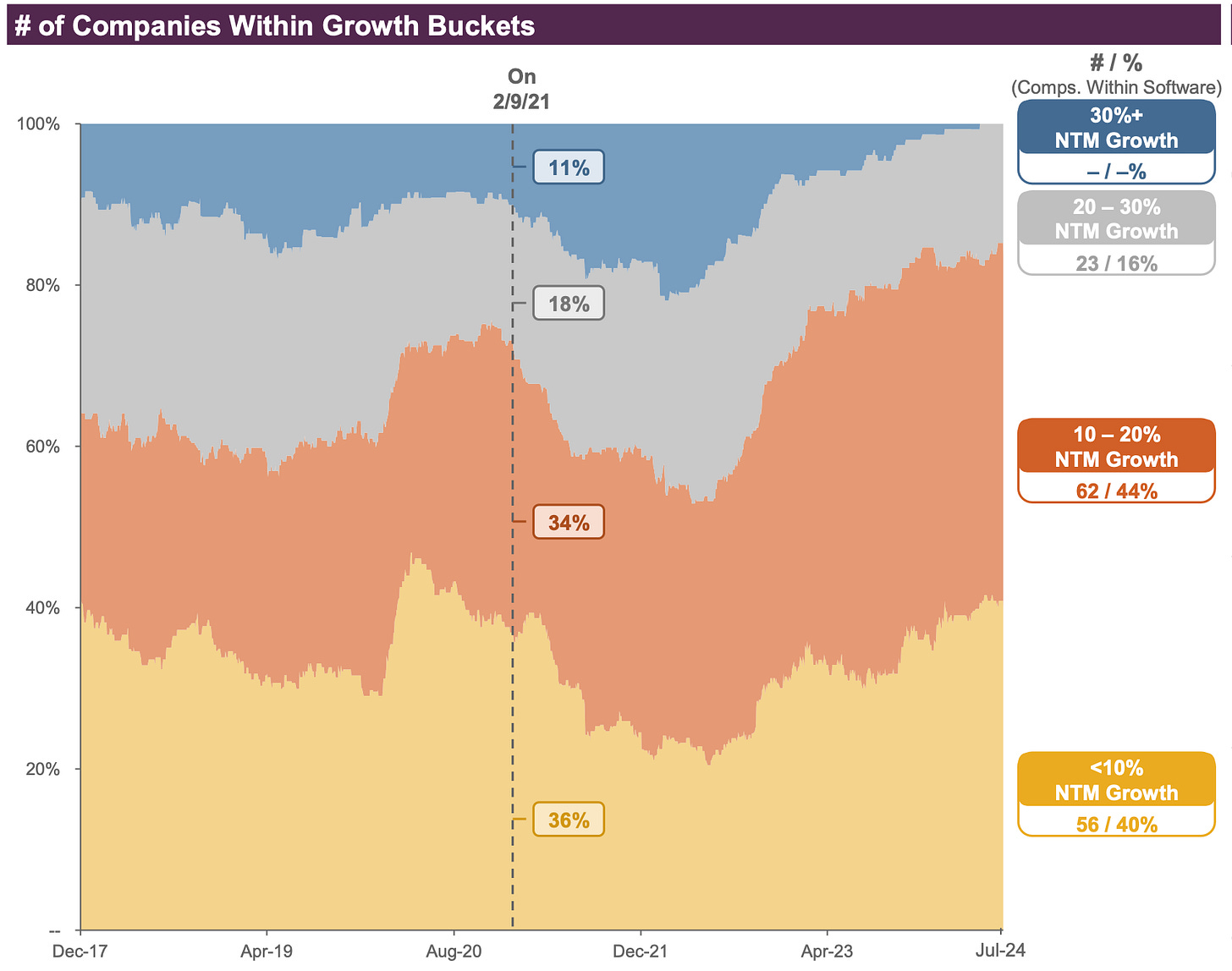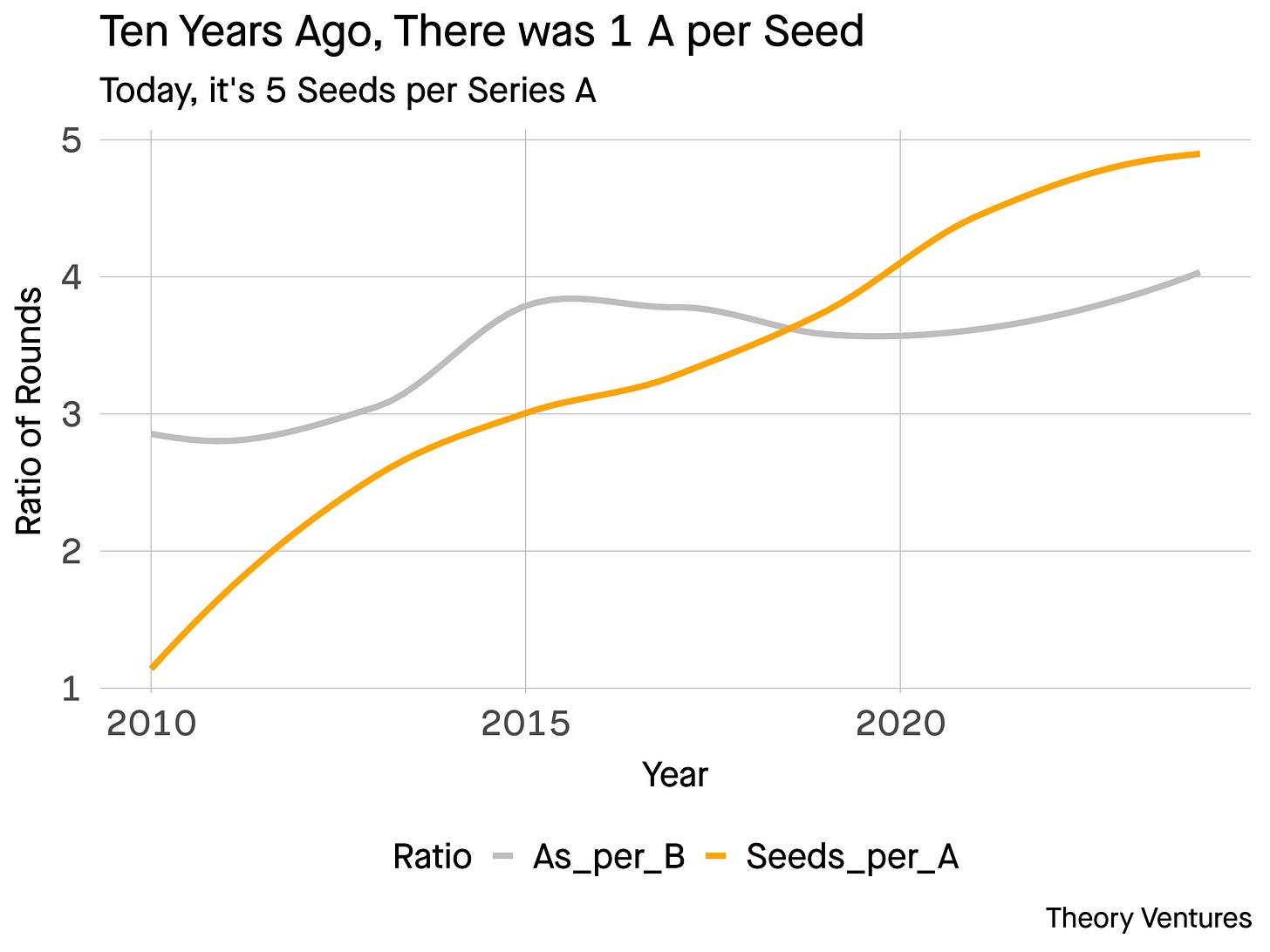Stay Informed: VC Q2 2024 Performance and Investor Sentiment
The Numbers Don’t Tell the Whole Story—Sentiment and Trends Shapes the Industry. Sales and Growth matter more than ever.
Introduction
Hello Cyber Builders 🖖
This week and next week, it is time to examine the VC market and its latest figures. Cyber Builders know that getting investor money is not the endgame, but it helps. Most of us either work for VC-backed companies or buy products from VC-backed companies. We are impacted by this market and the mood of the people working in it.
In an ever-fragile economy, the VC market reflects how VCs (e.g., the people, not the companies) see the future, how they think about the private markets, and how they are ready to make reasonable bets on a team, a technology, or a product. It also reflects growth potential and how big a company would be depending on its market, user expectations, and ability to sell.
Growth is probably the most important metric in the market nowadays. It is hard to understand why, but we can see a direct impact on the volume of deals and the extinction of 30%- 40% of growing companies at a significant stage (yes, at an early stage, growth is higher).
Investors are looking at the bottom of the river… see lower growth, few exist.. and wonder where to put their money.
We’ll see that the numbers are slightly better than in the previous quarter. Nothing very special as we are now in a back-to-basics area. I wrote extensively on it a few months ago:
In this Post
Q2 2024 VC market overview is showing a slight rebound in investments.
Generative AI and machine learning continue to dominate deal value.
Cybersecurity investments remain strong despite a slowdown in M&A activity.
The "Seed Apocalypse" makes Series A funding more challenging to secure in the U.S.
The European market is less affected by the "Seed Apocalypse" than the U.S..… but it suffers from other issues (Exits, baby!!).
State of the VC Market in Q2 2024
A picture worth thousands of words
The venture capital market made a slight comeback in Q2 2024. The capital raised moved from $18.7 billion to $20.9 billion. While these numbers are a step up from Q1, they still fall short of the $22 billion we saw in Q2 2023.
There is one big elephant in the room no one can ignore: Generative AI
Generative AI continues to lead the way all around the world
Investors continue their intense focus on AI and machine learning. According to PitchBook, almost half of the deal value in the U.S. was funneled into these “hottest” sectors. Investors see lasting value in generative AI and machine learning technologies, even as they become more cautious in other areas.
This trend is also true for Europe. Dealroom provides an excellent breakdown in Q2, and we
Q2 2024 Performance and Investor Sentiment
Despite these positive signs, the overall mood in the market remains cautious, and even with AI more and more people are having an “AI Hangover,” a theme for my following week's newsletter.
Regarding the macro economy, interest rates are hovering above 4%, and the US Federal Reserve only hints at possible rate cuts in September and October. The market fears a recession in 2024, and the latest data are not very encouraging. If you remove the “Magnificient Sevens” that are leveling up the indexes, the stock market already reflects this.
This cautious environment pushes VCs and early-stage investors to be more selective, with a strong preference for the most competitive ventures. The bar has been raised—startups need more than just potential; they need to show clear and sustained growth to catch the eye of investors. In today’s market, differentiation isn’t just a nice-to-have—it’s a necessity.
We also continue to see deals with high valuations even at very early stages, including pre-seeds when you have two founders and a pitch deck.
Potential founders within the Cyber Builders community must understand this: VCs have FOMO (Fear Of Missing Out). They fear these deals will be “the next big thing,” and they look only at a few factors:
How hot is the sub-space these AI / Cyber startups are jumping in?
What is the track record of the two or three founders?
If you are a second-time founder of a cybersecurity startup, having exited the previous one with Microsoft or Cisco, you have a good chance to raise millions on a valuation of tens of millions. If you are a top researcher on AI at Standford or a lead scientist at Google Deepmind, you can even raise hundreds of millions.
But without that space plus experience combo, you will never raise these amounts.
As Cyber Builders, you’d probably like to know the specifics of the cybersecurity metrics. Here they are.
Overview of 2024 Q2 Cybersecurity Deals
Cybersecurity continues to hold its ground in the venture capital world, with Q2 2024 showing a rebound in investment activity. While there’s some variation in the numbers—PitchBook reports $3.6 billion raised across 171 deals, while CrunchBase cites $4.4 billion over 153 deals—the message is clear: cybersecurity investment remains strong. Cybersecurity has ongoing importance.
Big startups attract big money
As the graph shows, we have fewer deals but more money raised…This means that the average number of deals is higher.
A few big late-stage deals and significant Series A rounds have driven mainly this quarter's boost in cybersecurity funding.
To name a few, Wiz took (before the $23B Google acquisition drama, which gave them even more visibility on the market) a $1B at $12B valuation (very very good market conditions). Cyera took $500M at a $1.2B valuation (see the difference).
M&A Activity: A Slowdown and a Shift
Mergers and acquisitions in cybersecurity have slowed down, with only 178 deals tracked in the first half of 2024, the lowest in recent memory, according to SecurityWeek. This slowdown suggests that many industry players are taking a “wait-and-see” approach, holding off on acquisitions until they can secure the correct valuations.
However, it’s worth noting that while the number of deals has dropped, there’s still a willingness to pay top dollar for highly differentiated companies. These companies have proven market potential and technological edge, making them prime targets for tech giants looking to enhance their platforms, like ZScaler, which bought Avalor for $310 M$ in cash and equity.
Interestingly, some of the biggest M&A deals labeled cybersecurity transactions involve broader IT, cloud, and networking acquisitions, where security is just one piece of the puzzle. For instance, HPE’s $14 billion acquisition of Juniper and IBM’s $6.4 billion acquisition of Archicorp are more about IT infrastructure than pure cybersecurity.
For Cyber Builders and entrepreneurs, it should remind them that a 100% pure security play is rare, and there are only a handful of 100% security companies. Even large successes like Splunk are security AND IT Ops/performance management.
The Seed Apocalypse: Myth or Reality?
“Series A Crunch” or “Seed Apocalypse” refers to the growing difficulty startups face when moving from Seed to Series A funding. Data from CARTA shows a sharp drop in the US in the percentage of startups that successfully pass that bar.
Back to Basics: The New Reality of Startup Growth
In the past, startups that secured Seed funding often found it relatively easy to raise a Series A, even with modest traction—sometimes, just a few customers and an essential product were enough. But in today’s market, that’s no longer the case. To land a Series A, startups must show significant growth, scalability, and a clear path to long-term market presence.
Currently, only 10% to 20% of companies that raise a Seed round manage to secure a Series A, a dramatic drop from the 50% to 60% success rates of recent years. Those higher rates were likely an anomaly, fueled by an unusually bullish market. Now, investors are more selective, focusing on startups with proven scalability.
This remarkable data from Guggenheim VC shows that the growth rate of SaaS companies has decreased over the last two years. This means looking for +30-50% revenue growth over the next twelve months (NTM) will not happen. Investors understand this and are experiencing it for their later-stage companies. Consequently, they are much more cautious before funding a new company at the Series A stage.
Read more at:
Are these guys able to grow? To match the valuation of X (say 100M$) with an average EV/NTM (enterprise value / next twelve-month revenue) ratio of 6, they need to hit the 15-20M$ revenue scale. How many years is it going to take?
These questions explain most VC investors' mindset and why moving from Seed to Series A is harder.
Is the “Seed Apocalypse” coming?
The “Seed Apocalypse” predicts the inevitable fallout for many startups that raised Seed funding in the last three years. With more money available during the post-COVID area, the number of Seed rounds grew significantly between 2020 and 2023. This means that we have a stock of seed-stage startups that, despite decent metrics, will struggle to secure Series A funding because of the higher expectations of VCs.
To deep dive, have a look to:
An insightful article by Alex Whelan, “Cautious Optimism,” shares a tweet about a startup generating $3 to $5 million in ARR (Annual Recurring Revenue) and growing well, yet still unable to raise a Series A. A few years ago, hitting $1 million ARR might have been enough to secure Series A funding. The challenge now is convincing investors that a startup can sustain its growth to much larger scales—$10 million, $20 million, $50 million, or even $100 million in ARR, and eventually head towards an IPO.
Thomasz Tunguz, another prolific writer and VC, also illuminates this trend, noting that in the U.S. market, there are currently about five Seed-stage startups for every Series A round.
That is the game the founders are in. Stay informed, Cyber Builders.
I don’t think what happens in the US happens in the EU
However, this “apocalypse” seems less severe in Europe, not because the expectations are lower, but because we haven’t created that “stock” of Seed startups.
The diagram below from Dealroom clearly shows that seed investment bumped slightly from 2020 to 2023 but not by a huge amount like in the US.
Moreover, as an EU Entrepreneur, I guarantee that raising a Series A was always tricky. Even with the (in)famous metric of $1M ARR, convincing VCs is always a challenge, as the size of the market and the willingness to move to unchartered technology or business model is lower than in the US.
Hopefully, things are changing fast. However, we still miss entrepreneurs with a committed global vision and international mindset. We are also missing EXITS.
What we are missing in Europe: Exits
What we are missing in Europe are sizeable exits. I guess I could write a longer post on this, looking at examples and trends, but in a nutshell, I see big issues.
We are lacking large aggregators—companies with a $5B+ turnover a year that need to sustain their growth to acquire companies with innovative products that are complementary and have a leverage effect on their business.
We are seeing a too-fragmented market. It is not easier for French companies to be acquired by German players than for US ones. Regulation-wise, it would be easier, but in terms of business, the culture is not there.
To know more, have a look to Julien’s post here (in French sorry)
Conclusion
In summary, the venture capital landscape in Q2 2024 shows signs of cautious optimism. While overall investment has slightly rebounded, the focus remains heavily on sectors like generative AI and machine learning.
Cybersecurity continues to attract significant investment, although M&A activity has slowed down. The "Seed Apocalypse" phenomenon highlights the growing challenges startups face in securing Series A funding, particularly in the U.S. market. However, this trend appears less pronounced in Europe.
As we progress, startups must demonstrate substantial growth and differentiation to capture investor interest in an increasingly selective market.
I am preparing more deep dive in the coming weeks. In the meantime, drop me your comments below 👇. Thanks 🙏
Laurent 💚














